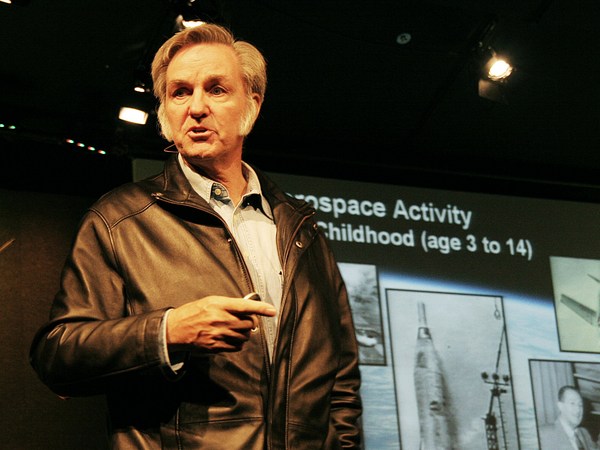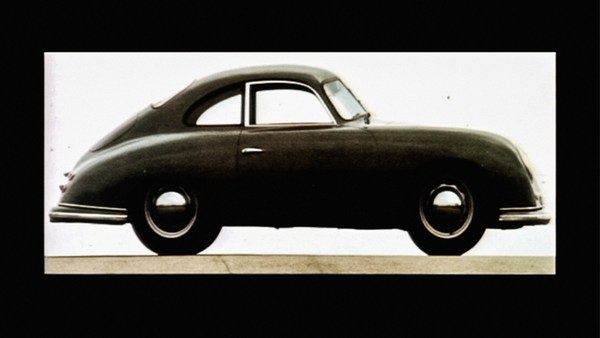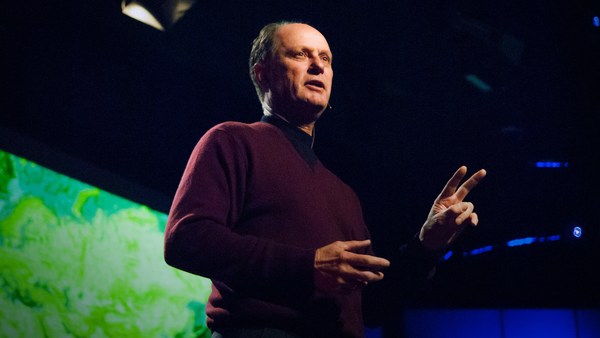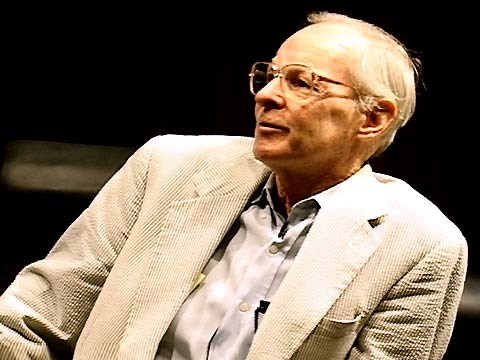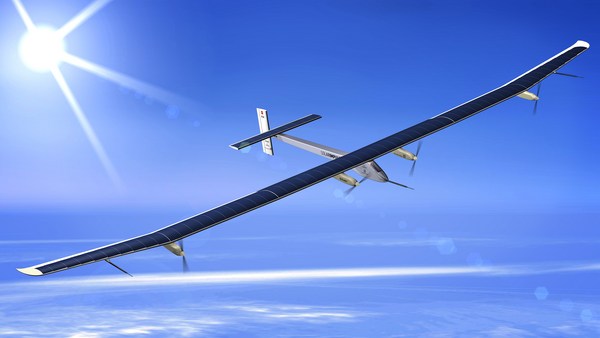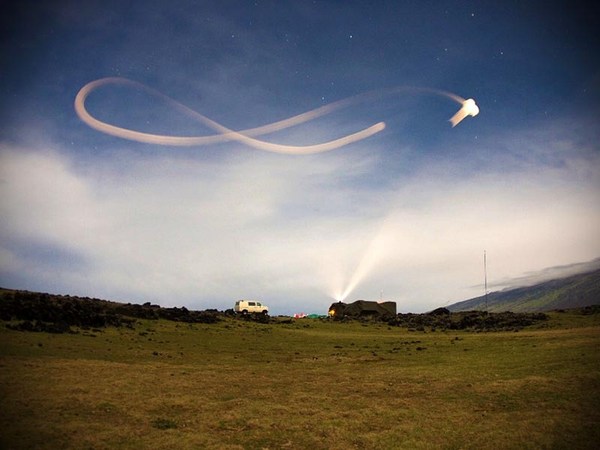I am known best for human-powered flight, but that was just one thing that got me going in the sort of things that I'm working in now. As a youngster, I was very interested in model airplanes, ornithopters, autogyros, helicopters, gliders, power planes, indoor models, outdoor models, everything, which I just thought was a lot of fun, and wondered why most other people didn't share my same enthusiasm with them. And then, navy pilot training, and, after college, I got into sailplane flying, power plane flying, and considered the sailplanes as a sort of hobby and fun, but got tangled up with some great professor types, who convinced me and everybody else in the field that this was a good way to get into really deep science.
While this was all going on, I was in the field of weather modification, although getting a Ph.D. in aeronautics. The weather modification subject was getting started, and as a graduate student, I could go around to the various talks that were being given, on a hitchhiker ride to the East Coast, and so on. And everybody would talk to me, but all the professionals in the field hated each other, and they wouldn't communicate. And as a result, I got the absolutely unique background in that field, and started a company, which did more research in weather modification than anybody, and there are a lot of things that I just can't go into. But then, 1971 started AeroVironment, with no employees -- then one or two, three, and sort of fumbled along on trying to get interesting projects. We had AirDynamisis, who, like I, did not want to work for aerospace companies on some big, many year project, and so we did our small projects, and the company slowly grew.
The thing that is exciting was, in 1976, I suddenly got interested in the human-powered airplane because I'd made a made a loan to a friend of 100,000 dollars, or I guaranteed the money at the bank. He needed them -- he needed the money for starting a company. The company did not succeed, and he couldn't pay the money back, and I was the guarantor of the note. So, I had a $100,000 debt, and I noticed that the Kramer prize for human-powered flight, which had then been around for -- (Laughter) -- 17 years at the time, was 50,000 pounds, which, at the exchange rate, was just about 100,000 dollars.
So suddenly, I was interested in human-powered flight -- (Laughter) -- and did not -- the way I approached it, first, thinking about ways to make the planes, was just like they'd been doing in England, and not succeeding, and I gave it up. I figured, nah, there isn't any simple, easy way. But then, got off on a vacation trip, and was studying bird flight, just for the fun of it, and you can watch a bird soaring around in circles, and measure the time, and estimate the bank angle, and immediately, figure out its speed, and the turning radius, and so on, which I could do in the car, as we're driving along on a vacation trip -- (Laughter) -- with my three sons, young sons, helping me, but ridiculing the whole thing very much.
But that began thinking about how birds went around, and then how airplanes would, how hang gliders would fly, and then other planes, and the idea of the Gossamer-Condor-type airplane quickly emerged, was so logical, one should have thought of it in the first place, but one didn't. And it was just, keep the weight down -- 70 pounds was all it weighed -- but let the size swell up, like a hang glider, but three times the span, three times the cord. You're down to a third of the speed, a third of the power, and a good bicyclist can put out that power, and that worked, and we won the prize a year later.
We didn't -- a lot of flying, a lot of experiments, a lot of things that didn't work, and ones that did work, and the plane kept getting a little better, a little better. Got a good pilot, Brian Allen, to operate it, and finally, succeeded. But unfortunately, about 65,000 dollars was spent on the project.
(Laughter)
And there was only about 30 to help retire the debt. But fortunately, Henry Kramer, who put up the prize for -- that was a one-mile flight -- put up a new prize for flying the English Channel, 21 miles. And he thought it would take another 18 years for somebody to win that. We realized that if you just cleaned up our Gossamer Condor a little bit, the power to fly would be decreased a little bit, and if you decrease the power required a little, the pilot can fly a much longer period of time. And Brian Allen was able, in a miraculous flight, to get the Gossamer Albatross across the English Channel, and we won the 100,000-pound, 200,000-dollar prize for that. And when all expenses were paid, the debt was handled, and everything was fine. It turned out that giving the planes to the museum was worth much more than the debt, so for five years, six years, I only had to pay one third income tax. So, there were good economic reasons for the project, but -- (Laughter) --
that's not, well, the project was done entirely for economic reasons, and we have not been involved in any human-powered flight since then -- (Laughter) -- because the prizes are all over. (Laughter) But that sure started me thinking about various things, and immediately, we began making a solar-powered plane because we felt solar power was going to be so important for the country and the world, we didn't want the small funding in the government to be decreased, which is what the government was trying to do with it. And we thought a solar-powered plane wouldn't really make sense, but you could do it and it would get a lot of publicity for solar power and maybe help that field. And that project continued, did succeed, and we then got into other projects in aviation and mechanical things and ground devices.
But while this was going on, in 1982, I got a prize from the Lindbergh Foundation -- their annual prize -- and I had to prepare a paper on it, which collected all my varied thoughts and varied interests over the years. This was the one chance that I had to focus on what I, really, was after, and what was important. And to my surprise, I realized the importance of environmental issues, which Charles Lindbergh devoted the last third of his life to, and preparing that paper did me a lot of good. I thought back about if I was a space traveler, and came and visited Earth every 5,000 years. And for a few thousand visits, I would see the same thing every time, the little differences in the Earth.
But this last time, just coming round, right now, suddenly, there'd be huge changes in the environment, in the concentration of people, and it was just unbelievable, the amount of -- all the change in it. I wanted to -- well, one of the biggest changes is, 200 years ago, we began using coal from underground, which has a lot of pollution, and 100 years ago, began getting gasoline from underground, with a lot of pollution. And gasoline consumption, or production, will reach its limit in about ten years, and then go down, and we wonder what's going to happen with transportation.
I wanted to show the slide -- this slide, I think, is the most important one any of you will see, ever, because -- (Laughter) (Applause) -- it shows nature versus humans, and goes from 1850 to 2050. And so, the year 2000, you see there. And this is the weight of all air and land vertebrates. Humans and muskrats and giraffes and birds and so on, are -- the red line goes up. That's the humans and livestock and pets portion. The green line goes down. That's the wild nature portion. Humans, livestock and pets are, now, 98 percent of the total world's mass of vertebrates on land and air. And you don't know what the future will hold, but it's not going to get a lower percentage. Ten thousand years ago, the humans and livestock and pets were not even one tenth of one percent and wouldn't even have been visible on such a curve. Now they are 98 percent, and it, I think, shows human domination of the Earth.
I give a talk to some remarkable high school students each summer, and ask them, after they've asked me questions, and I give them a talk and so on. Then I ask them questions. What's the population of the Earth? What's the population of the Earth going to be when you're the age of your parents? Which I'd never, really -- they had never, really, thought about but, now, they think about it. And then, what population of the Earth would be an equilibrium that could continue on, and be for 2050, 2100, 2150? And they form little groups, all fighting with each other, and when I leave, two hours later, most of them are saying about 2 billion people, and they don't have any clue about how to get down to 2 billion, nor do I, but I think they're right and this is a serious problem.
Rachel Carson was thinking of these, and came out with "Silent Spring," way back. "Solar Manifesto" by Hermann Scheer, in Germany, claims all energy on Earth can be derived, for every country, from solar energy and water, and so on. You don't need to dig down for these chemicals, and we can do things much more efficiently. Let's have the next slide. So this just summarizes it. "Over billions of years, on a unique sphere, chance has painted a thin covering of life -- complex and probable, wonderful and fragile.
Suddenly, we humans, a recently arrived species, no longer subject to the checks and balances inherent in nature, have grown in population, technology and intelligence to a position of terrible power. We, now, wield the paintbrush." We're in charge. It's frightening. And I do a painting every 20 or 25 years. This is the last one. (Laughter) And [it] shows the Earth in a time flag: on the right, in trilobites and dinosaurs and so on; and over the triangle, we now get to civilization and TV and traffic jams and so on. I have no idea of what comes next, so I just used robotic and natural cockroaches as the future, as a little warning. And two weeks after this drawing was done, we actually had our first project contract, at AeroVironment, on robotic cockroaches, which was very frightening to me.
(Laughter) (Paper rustling)
Well, that'll be all the slides. As time went on, we stopped our environmental programs. We focused more on the really serious energy problems of the future, and we produced products for the company. And we developed the impact car that General Motors made, the EV1, out of -- and got the Air Resources Board to have the regulations that stimulated the electric cars, but they've since come apart. And we've done a lot of things, small drone airplanes and so on. I have a Helios. We have the first video.
(Video) Narrator: With a wingspan of 247 feet, this makes her larger than a Boeing 747.
(Music)
Her designers' attention to detail and her construction gives Helios' structure the flexibility and strength to deal with the turbulence encountered in the atmosphere. This enables her to easily ride through the air currents as if she's sliding along on the ocean waves.
Paul MacCready: The wings could touch together on top and not break. We think.
(Laughter)
Narrator: And Helios now begins the process of turning her back to the sun, to maximize the power from her solar array.
(Music) As the sky gets darker, and the outside air temperatures drop below minus 100 degrees Fahrenheit, the most environmentally hostile segment of Helios's journey has gone by without notice, except for being recorded by specially designed data acquisition systems and their associated sensors. Approaching a peak radar altitude of 96,863 feet, at 4:12 p.m., Helios is standing on top of 98 percent of the Earth's atmosphere. This is more than 10,000 feet higher than the previous world's altitude record held by the SR-71 Blackbird.
(Applause)
PM: That plane has many purposes, but it's aimed for communications, and it can fly so slowly that it'll just stay up at 65,000 feet. Eventually, it will be able to have to stay up day, night, day, night, for six months at a time, acting like the synchronous satellite, but only ten miles above the Earth. Let's have the next video. This shows the other end of the spectrum.
(Video) Narrator: A tiny airplane, the AV Pointer serves for surveillance. In effect a pair of roving eyeglasses, a cutting-edge example of where miniaturization can lead if the operator is remote from the vehicle. It is convenient to carry, assemble, and launch by hand. Battery-powered, it is silent and rarely noticed. It sends high-resolution video pictures back to the operator. With on-board GPS, it can navigate autonomously, and it is rugged enough to self-land without damage.
PM: Okay, and let's have the next.
(Applause)
That plane is widely used by the military, now, in all their operations. Let's have the next video.
(Video) (Music)
Alan Alda: He's got it, he's got it, he's got it on his head.
(Music)
We're going to end our visit with Paul MacCready's flying circus by meeting his son, Tyler, who, with his two brothers, helped build the Gossamer Condor, 25 years ago.
Tyler MacCready: You can chase it, like this, for hours.
AA: When they got bored with their father's project, they invented an extraordinary little plane of their own.
TM: And I can control it by putting the lift on one side of the wing, or on the other.
AA: They called it their Walkalong Glider.
(Music)
I've never seen anything like that. How old were you when you invented that?
TM: Oh, 10, 11. (AA: Oh my God.)
TM: 12, something like that. (AA: That's amazing.)
PM: And Tyler's here to show you the Walkalong.
(Applause)
TM: All right. You all got a couple of these in your gift bags, and one of the first things, the production version seemed to dive a little bit, and so I would just suggest you bend the wing tips up a little bit before you try flying it. I'll give you a demonstration of how it works. The idea is that it soars on the lift over your body, like a seagull soaring on a cliff. As the wind comes up, it has to go over the cliff, so as you walk through the air, it goes around your body, some has to go over you. And so you just keep the glider positioned in that up current. The launch is the difficult part: you've got to hold it high up, over your head, and you start walking forward, and just let go of it, and you can control it like that.
(Laughter)
And then also, like it said in the video, you can turn it left or right just by putting the lift under one wing or another. So I can do it -- oops, that was going to be a right turn.
(Laughter)
Okay, this one will be a left turn. Here, but -- (Applause) -- anyway. (Applause) And that's it, so you can just control it, wherever you want, and it's just hours of fun. And these are no longer in production, so you have real collector's items.
(Laughter)
And this, we just wanted to show you -- if we can get the video running on this, yeah -- just an example of a little video surveillance.
(Laughter)
This was flying around in the party last night, and -- (Laughter) -- you can see how it just can fly around, and you can spy on anybody you want.
(Laughter)
And that's it. I was going to bring an airplane, but I was worried about hitting people in here, so I thought this would be a little bit more gentle. And that's it, yeah, just a few inventions. (Applause) All right.
